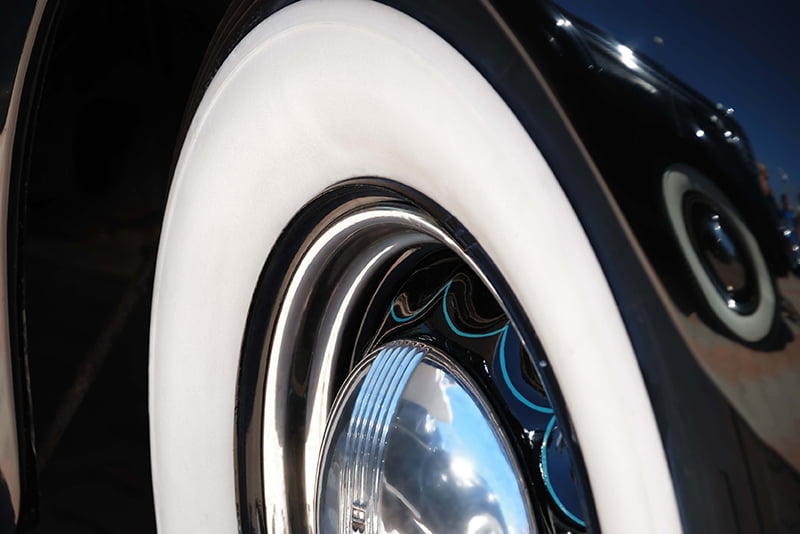While vintage and classic car lovers often fan over the engines of yesteryear, the original whitewall tyres used on these makes and models are often forgotten.
Unsurprisingly, it’s not just the revheads that love the iconic vehicles of yesteryear. Iconic cars don’t only appeal to car lovers, but also attract those passionate about engineering, design, art and yes, history. Before cars were built for efficiency and speed, it was about the experience, style, exclusivity and ultimately, craftsmanship – making them timeless, works of art.
However, the overall look and feel of these physical representations of a bygone era wouldn’t quite be the same without the smaller details that are often overlooked, and that includes the magic of whitewall tyres – so where did it all begin?
The Introduction Of Whitewall Tyres
In the automotive world, whitewall tyres were once a staple of modern luxury. While they arrived on the market in the early 1900’s, it’s no coincidence that they began to fall out of favour right around the time that the American automotive industry came crashing down around the mid 1970’s. The distinctive white sidewall would remain an option for factory tyres into the early ‘80s, but few would tick the box, and by the end of the decade you had to dig deep or visit a specialty manufacturer to get a set for your classic car.
Although seventy years at the top is quite the feat, the origins of whitewall tyres are surprisingly simple: pure rubber just doesn’t wear that well. One of the earliest success stories in mixing chemical compounds into car tyres was zinc oxide, which oddly enough also created a completely white tyre as a notable side effect. The use of whitewall rubber for tyres has been traced to a small tyre company in Chicago called Vogue Tyre And Rubber Co, that made them for their horse and chauffeur drawn carriages as early as 1914.
By the time carbon black arrived on the scene and gave us the black rubber tyres that we’re all familiar with, white rubber was the go-to. The carbon was initially applied exclusively to the treaded part of the tyre, leaving the sidewalls white as a visual advertisement that you were rocking the best set of tyres that money could buy at the time.
When the black tyres first became available, they were commonly fitted to many luxury cars through the 1930’s in the United States. During the late 1920’s, gleaming whitewalls contrasted against darker surroundings were considered a stylish, but high-maintenance feature. The popularity of whitewall tyres as a staple feature increased during the 1930’s, during which time Ford introduced whitewalls as an $11.25 optional extra on all of it’s new models.
There’s no doubt that whitewall tyres reached the height of their popularity during the 1950’s, at which time they featured on iconic releases such as the Cadillac Eldorado Brougham. This model in particular was fitted with whitewall tyres that were reduced to a 1″ wide stripe floating on the tire sidewall, with a black area between this stripe and the wheel rim. However, the whitewall stripe width soon began to diminish, as an attempt to reduce the perceived height of the wheel and tyre. During the decade, the cars became lower, and in turn the visibility of the wheels and tyres were diminished.
Wide whitewalls generally started to fall out of favour in the United States by the 1962 model year. They continued as an option on the Lincoln Continental for some time thereafter, but the narrower 3/4″-1″ stripe whitewalls were becoming increasingly more common. In some cases, having whitewall tyres were deemed to be a “must have” to get the right look on a car. For those who could not afford the real deal, add-ons could be installed over the rim of the wheel that could leak if the pressure was too high.
Needless to say that these days, whitewall tyres have actually never fallen out of favour in some circles. Although they are certainly not a keynote with modern automotive production, that doesn’t mean that vintage car collectors still can’t get their hands on whitewall tyres.
With the hot rod community and classic car enthusiasts keeping the flame alive, this generation’s collector car boom saw companies like Vogue and Coker making a decent living off of reproduction and original designs from revheads who want to get the look “just” right.
Your Guide To Everything Classic Cars
Finding a fellow vintage auto enthusiast can feel a bit like finding a needle in a haystack, but rest assured that Classic’s Garage understands the thrill more than most. Having spent forty years collecting anything and everything from matchbox cars to hub caps, he’s successfully followed his passion to source, collect and stock beautiful and low mileage classic automobiles from around the world. With extensive experience in the automotive industry, it was only a matter of time before Wayne expanded on his love of vintage, iconic vehicles to share his knowledge and passion with the public.
Although his passion is for automobiles built before 1978, with a particular love for Buicks, Cadillacs, Lincolns, Oldsmobiles and even Fords, Wayne is just as passionate about the stories of the owners. Just like the cars, he has found that his fellow classic car enthusiasts all have wildly different attractions and logic behind their passion or hobby, and this often translates into how the car is presented. If it’s even remotely different, rare or just plain unusual, Wayne will overcome the relevant logistical and geographical challenges of bringing the cars to his showroom in Australia.
Classic’s Garage is a showroom conveniently located at Seventeen Mile Rocks, that specialises in the restoration and sales of vintage automobiles. If you’re on the hunt for Brisbane classic cars – quite simply, Wayne is your man. If you would like to arrange a viewing or inspect any other of our classic vehicles, please get in touch with us today.

